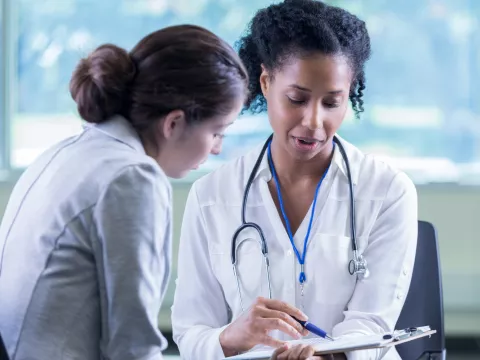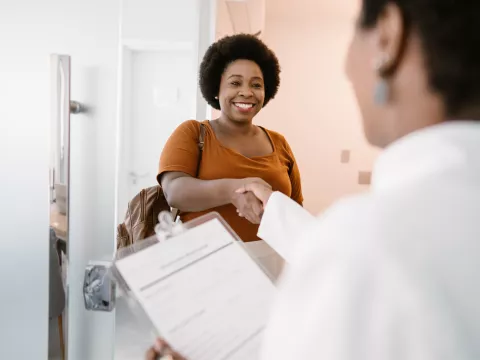- AdventHealth

Choose the health content that’s right for you, and get it delivered right in your inbox.
Uterine fibroids are a common cause of pelvic pain. They’re also the most common type of tumor found in the uterus, but they very rarely develop into cancer. Still, they can cause debilitating pain and discomfort in women who may not even know they have them.
If you think you may have uterine fibroids, or have been recently diagnosed, we’re here to explain the basics of this common gynecological condition, including types of uterine fibroids, causes, symptoms and treatment options.
What Are Uterine Fibroids?
Uterine fibroids are smooth, muscular tumors that form around the uterus. Most women will develop one or more fibroids in their lifetime, but most of them don’t cause problems. You may not even know you have fibroids until you receive a routine pelvic exam.
Fibroids can grow singularly or in clusters and range in size from microscopic to large masses. Uterine fibroids can sometimes become large enough to cause visible swelling in the abdomen.
Types of Uterine Fibroids
There are three main types of uterine fibroids. The classification depends on where it develops in your uterus. The three types include:
- Intramural fibroids: develop within the muscular wall of the uterus
- Subserosal fibroids: develop on the outside of your uterus (serosa)
- Submucosal fibroids: develop in the middle muscle layer of your uterus (myometrium)
What Causes Uterine Fibroids?
It isn’t clear what causes uterine fibroids, but we know some factors that lead to their development. These factors include:
- Hormones: estrogen and progesterone (which occur naturally and in larger amounts before menopause) appear to promote fibroid growth
- Genetic mutations: fibroids may contain gene changes that make them different than typical muscle cells found in the uterus
- Family history: if other female members of your family have fibroids, you may develop them as well
- Lifestyle choices: some known risk factors include obesity, vitamin D deficiency, alcohol consumption and eating a lot of red meat
- Pregnancy: estrogen and progesterone levels increase during pregnancy, and many fibroids will shrink or disappear when the uterus returns to its normal size after childbirth
Symptoms of Uterine Fibroids
Many women with fibroids don’t experience any problems; however, sometimes they can cause painful symptoms that mimic endometriosis symptoms, including:
- Bloating and constipation
- Cramps, backache or pain in your legs
- Heavy menstrual bleeding
- Overly painful or prolonged periods that last more than a week
- Painful intercourse
- Pelvic pain or pressure that doesn’t go away
In some cases, uterine fibroids can lead to infertility issues. If you’re having trouble conceiving, request an appointment with one of our gynecological experts. We’ll help you determine if uterine fibroids could be the cause.
How to Treat Uterine Fibroids
We can use a few methods to treat fibroids. Treatment will depend on the size, number and type of fibroids. If this condition affects your daily life, your doctor may recommend a robotic-assisted surgical excision of uterine fibroids.
This minimally invasive procedure to remove uterine fibroids offers a lower risk of complications than other surgical methods, and it has a shorter recovery time. It also lets your doctor remove fibroids that are otherwise difficult to reach.
Other treatment options include safely waiting them out, hormonal contraceptives, intrauterine devices (IUDs) and other medications that help balance your menstrual cycle.
Diagnosing Uterine Fibroids
The best way to diagnose the cause of your pelvic pain is to see your health care provider. At AdventHealth, our expert team of caring providers will provide an accurate diagnosis and comprehensive care plan. We won’t stop until we understand the cause of your symptoms, and we’ll work to help you find lasting relief so you can get back to living your best life.
Learn more about our women’s care services. You deserve to feel whole.




